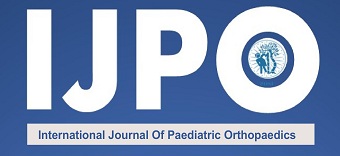A Case of Osteofibrous Dysplasia Treated with a Hybrid Approach: Clinical and Radiological Outcomes
Volume 10 | Issue 3 | September-December 2024 | Page: 33-38 | Vivek Madankar, K. Ramkumar Reddy, Roshan Kumar Mohanty
DOI- https://doi.org/10.13107/ijpo.2024.v10.i03.208
Open Access License: CC BY-NC 4.0
Copyright Statement: Copyright © 2024; The Author(s).
Submitted: 15/11/2024; Reviewed: 22/11/2024; Accepted: 01/12/2024; Published: 10/12/2024
Authors: Vivek Madankar MS Ortho [1], K. Ramkumar Reddy MS Ortho [1], Roshan Kumar Mohanty MS Ortho [1]
[1] Department of Orthopaedics, Kakatiya Medical College, Warangal, Telangana, India.
Address of Correspondence
Dr. Vivek Madankar,
Department of Orthopaedics, Kakatiya Medical College, Warangal, Telangana, India.
E-mail: vivekmadankar@gmail.com
Abstract
Introduction: Osteofibrous dysplasia (OFD) is a rare, benign, and self-limiting fibro-osseous lesion primarily affecting the cortical bone of the tibia and fibula in children and adolescents. OFD presents diagnostic challenges due to its clinical and radiological resemblance to adamantinoma, a malignant bone tumor. Accurate diagnosis and appropriate treatment are essential to prevent complications and recurrence.
Case Report: We report the case of an 11-year-old boy with a four-month history of pain and a longstanding swelling in his right tibia. Clinical examination revealed a firm, well-circumscribed lesion in the tibial cortex. Imaging demonstrated a mixed sclerotic and lytic lesion with characteristic features, including a multilocular “soap bubble” appearance. Histopathological evaluation confirmed the diagnosis of OFD. The patient underwent a hybrid treatment approach involving surgical excision sparing the posterior cortex, followed by functional cast bracing. This strategy facilitated early mobilization and complete recovery. Radiological evaluation at six weeks demonstrated neo-osteogenesis, with full bone healing achieved by 12 weeks. At the two-year follow-up, the patient exhibited full functional recovery with no signs of recurrence.
Conclusion: This case highlights the successful management of OFD using a hybrid surgical and non-surgical approach, emphasizing the importance of accurate diagnosis and tailored treatment strategies. Combining surgical resection with functional bracing allowed for effective management, early weight-bearing, and prevention of complications. This approach adds to the orthopedic literature by illustrating an alternative, cost-effective treatment protocol for this rare bone disorder.
Keywords: Osteofibrous dysplasia, Tibial lesion, Hybrid treatment, Surgical excision, Functional cast bracing, Pediatric orthopedics
References
1. Yoshino K, Nakamura J, Hagiwara S, Suzuki T, Kawasaki Y, Ohtori S. Anatomical implications regarding femoral nerve Palsy during a direct Anterior Approach to Total Hip Arthroplasty A Cadaveric Study. J Bone Joint Surg. 2020;102(2):137–142.
2. Lee RS, Weitzel S, Eastwood DM, Monsell F, Pringle J, Cannon SR, Briggs TWR. Osteofibrous dysplasia of the tibia: is there a need for a radical surgical approach? J Bone Joint Surg – Ser B. 2006;88(5):658–664
3. Park YK, Unni KK, McLeod RA, Pritchard DJ. Osteofibrous dysplasia: clinicopathologic study of 80 cases. Hum Pathol. 1993;24(12):1339-1347
4. Lichtenstein L. Polyostotic fibrous dysplasia. Arch Surg. 1938;36:874–898.
5. Westacott D, Kannu P, Stimec J, Hopyan S, Howard A. Osteofibrous dysplasia of the Tibia in Children: Outcome without Resection. J Pediatr Orthop. 2019;39(8): 614–621.
6. Yamamura Y, Emori M, Takahashi N, Chiba M, Shimizu J, Murahashi Y, et al. Osteofibrous dysplasia-like adamantinoma treated via intercalary segmental resection with partial cortex preservation using pedicled vascularized fibula graft: a case report. World J Surg Oncol. 2020;18(1): 203-213.
7. Goto T, Kojima T, Iijima T, Yokokura S, Kawano H, Yamamoto A, Matsuda K. Osteofibrous dysplasia of the ulna. J Orthop Sci. 2001;6(6):608-611.
8. Seligson D. CORR insights ®: does fracture affect the healing time or frequency of recurrence in a simple bone cyst of the proximal femur? Clin Orthop Relat Res. 2014;472(10):3177–3178.
9. Yoshida S, Watanuki M, Hayashi K, Hosaka M, Hagiwara Y, Itoi E, et al. Osteofibrous dysplasia arising in the humerus: a case report. Rare Tumors. 2018;10:e2036361318808852.
10. Khanna M, Delaney D, Tirabosco R, Saifuddin A. Osteofibrous dysplasia, osteofibrous dysplasia-like adamantinoma and adamantinoma: correlation of radiological imaging features with surgical histology and assessment of the use of radiology in contributing to needle biopsy diagnosis. Skeletal Radiol. 2008;37(12):1077–1084.
11. Papagelopoulos PJ, Mavrogenis AF, Galanis EC, Savvidou OD, Inwards CY, Sim FH. Clinicopathological features, diagnosis, and treatment of adamantinoma of the long bones. Orthopedics. 2007;30(3):211–215.
12. Scholfield DW, Sadozai Z, Ghali C, Sumathi V, Douis H, Gaston L, et al. Does osteofibrous dysplasia progress to adamantinoma and how should they be treated? Bone Joint J. 2017;99–B(3):409–416.
13. Treurniet S, Eekhoff EM, Schmidt FN, Micha D, Busse B, Bravenboer N. A clinical perspective on advanced developments in bone biopsy assessment in rare bone disorders. Front Endocrinol.2020;11:399-410.
14. Westacott D, Kannu P, Stimec J, Hopyan S, Howard A. Osteofibrous dysplasia of the tibia in children: outcome without resection. J Pediatr Orthop. 2019;39(8): 614-621.
15. Kamal AF, Anshori F, Kodrat E. Osteofibrous dysplasia-like adamantinoma versus osteofibrous dysplasia in children: a case report of challenging diagnosis. Int J Surg Case Rep. 2021;80:e105599.
16. Scholfield DW, Sadozai Z, Ghali C, Sumathi V, Douis H, Gaston L, Grimer RJ, Jeys L. Does osteofibrous dysplasia progress to adamantinoma and how should they be treated?. Bone Joint J. 2017;99(3):409-416.
17. Parra O, Linos K. Molecular pathogenesis of soft tissue and bone tumors. Diagnostic Molecular Pathology. Academic Press.2024:485-551.
18. Agaram NP. Molecular genetics of bone tumors. Diagn Histopathol. 2022;28(12):541-551.
| How to Cite this Article: Madankar V, Reddy KR, Kumar R | A Case of Osteofibrous Dysplasia Treated with a Hybrid Approach: Clinical and Radiological Outcomes | International Journal of Paediatric Orthopaedics | September-December 2024; 10(3): 33-38. |

